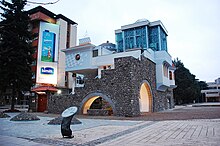
 Consecrated religious, nun Born Anjezë Gonxhe Bojaxhiu
Consecrated religious, nun Born Anjezë Gonxhe Bojaxhiu Institute Sisters of Loreto
Institute Sisters of LoretoMary Teresa Bojaxhiu[6] (born Anjezë Gonxhe Bojaxhiu, Albanian: [aˈɲɛzə ˈɡɔndʒɛ bɔjaˈdʒiu]; 26 August 1910 – 5 September 1997), commonly known as Mother Teresa and honoured in the Catholic Church as Saint Teresa of Calcutta,[7] was an Albanian-Indian[4] Roman Catholic nun and missionary.[8] She was born in Skopje (now the capital of North Macedonia), then part of the Kosovo Vilayet of the Ottoman Empire. After living in Skopje for eighteen years, she moved to Ireland and then to India, where she lived for most of her life.
In 1950, Teresa founded the Missionaries of Charity, a Roman Catholic religious congregation that had over 4,500 nuns and was active in 133 countries in 2012. The congregation manages homes for people who are dying of HIV/AIDS, leprosy and tuberculosis. It also runs soup kitchens, dispensaries, mobile clinics, children's and family counselling programmes, as well as orphanages and schools. Members take vows of chastity, poverty, and obedience, and also profess a fourth vow—to give "wholehearted free service to the poorest of the poor."[9]
Teresa received a number of honours, including the 1962 Ramon Magsaysay Peace Prize and 1979 Nobel Peace Prize. She was canonised on 4 September 2016, and the anniversary of her death (5 September) is her feast day.
A controversial figure during her life and after her death, Teresa was admired by many for her charitable work. She was praised and criticized on various counts, such as for her views on abortion and contraception, and was criticized for poor conditions in her houses for the dying. Her authorized biography was written by Navin Chawla and published in 1992, and she has been the subject of films and other books. On 6 September 2017, Teresa and St. Francis Xavier were named co-patrons of the Roman Catholic Archdiocese of Calcutta.


Teresa was born Anjezë Gonxhe (or Gonxha)[10] Bojaxhiu (Albanian: [aˈɲɛzə ˈɡɔndʒɛ bɔjaˈdʒiu]; Anjezë is a cognate of "Agnes"; Gonxhe means "rosebud" or "little flower" in Albanian) on 26 August 1910 into a Kosovar Albanian family[11][12][13] in Skopje (now the capital of North Macedonia), Ottoman Empire.[14][15] She was baptised in Skopje, the day after her birth.[10] She later considered 27 August, the day she was baptised, her "true birthday".[14]
She was the youngest child of Nikollë and Dranafile Bojaxhiu (Bernai).[16] Her father, who was involved in Albanian-community politics in Ottoman Macedonia, died in 1919 when she was eight years old.[14][17] He may have been from Prizren, Kosovo, and her mother may have been from a village near Gjakova.[18]
According to a biography by Joan Graff Clucas, Teresa was in her early years when she was fascinated by stories of the lives of missionaries and their service in Bengal; by age 12, she was convinced that she should commit herself to religious life.[19] Her resolve strengthened on 15 August 1928 as she prayed at the shrine of the Black Madonna of Vitina-Letnice, where she often went on pilgrimages.[20]
Teresa left home in 1928 at age 18 to join the Sisters of Loreto at Loreto Abbey in Rathfarnham, Ireland, to learn English wit
